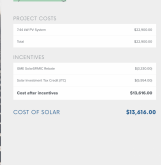Hey guys, I need some help sorting through some thoughts. I am in the Dallas, tx area. First, my long term goal is to eventually be grid-tied with Solar. I am currently paying 9.1¢ per kWh* and using about 1200/kWH per month. I need to do this in spirts, due to the upfront cost but want something I can eventually expand easily. Initially, I would like to have a 1 or more days backup in case of power outages (assuming I can charge them fast enough in the day. I am not looking to power the entire home, just a few items (AC or gas heat pump), kitchen fridge, (1) 65-inch tv, internet, 2 laptops a lamp or 2, Microwave and charge the cell phones. (lets assume, everything will run for 5-6 hours a day)
Now with that background info, I travel on and off for work and want it to be fairly easy for my wife to operate, should I be on the road.
I could get a gas/propane generator (not an entire home system, but the smaller system?), install a manual transfer switch and wire the room that has basically all the items. Pro/con - cheapest solution, can get that done in 1 day, no extension cords etc. Con, noise, fuel storage (looks to be about ~2500.00) all in
Install the full gas auto-transfer system (looks to be about 7-10k all in) - Pro/Con - expensive, but easy.. Takes me away from my solar goals
Go with a Small solar grid-tie system - this is where i get stuck - maybe 4-6 panels, batteries, BMS, inverter, it seems like it needs to be grid-tied or have a transfer switch. (cost~4k? )
any thoughts
Now with that background info, I travel on and off for work and want it to be fairly easy for my wife to operate, should I be on the road.
I could get a gas/propane generator (not an entire home system, but the smaller system?), install a manual transfer switch and wire the room that has basically all the items. Pro/con - cheapest solution, can get that done in 1 day, no extension cords etc. Con, noise, fuel storage (looks to be about ~2500.00) all in
Install the full gas auto-transfer system (looks to be about 7-10k all in) - Pro/Con - expensive, but easy.. Takes me away from my solar goals
Go with a Small solar grid-tie system - this is where i get stuck - maybe 4-6 panels, batteries, BMS, inverter, it seems like it needs to be grid-tied or have a transfer switch. (cost~4k? )
any thoughts





